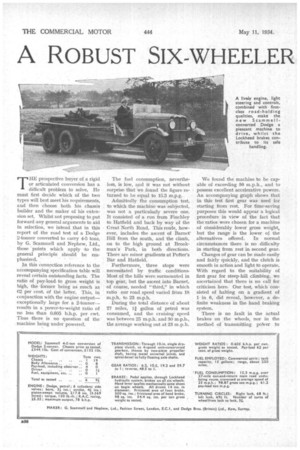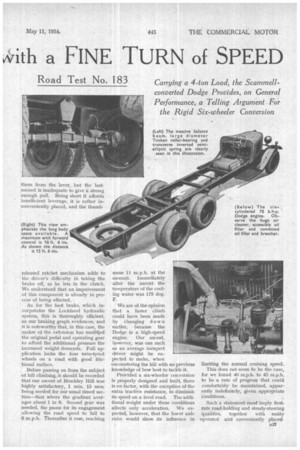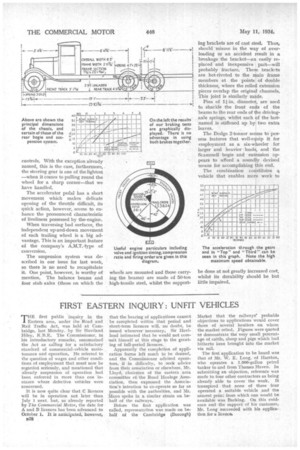A ROBUST SIX-WHEELER
Page 54

Page 55

Page 56

If you've noticed an error in this article please click here to report it so we can fix it.
vvith a FINE TURN of SPEED THE prospective buyer of a rigid or articulated conversion has a difficult problem to solve. He must first decide which of the two types will best meet his requirements, and then choose both his chassis builder and the maker of his extension set. Whilst not proposing to put forward any general arguments to aid in selection, we intend that in this report of the road test of a Dodge 2-tonner converted to carry 4-5 tons, by G. Scammell and Nephew, Ltd., those 'points which apply to the general principle should be em
phasized. .
In this connection reference to the accompanying specification table will reveal certain outstanding facts. The ratio of pay-load to gross weight is high, the -former being as much as 62 per cent, of the latter. This, in conjunction with the engine output— exceptionally large for a 2-tonnerresults in a power-to-weight ratio of no less than 0.605 b.h,p. per cwt. Thus there is no question of the machine being under powered.
The fuel consumption, nevertheless, is low, and it was not without surprise that we found the figure returned to be equal to 15.3 m.p.g.
Admittedly the consumption test, to which the machine was subjected, was not a particularly severe one. It consisted of a run from Finchley to Hatfield and back by way of the Great North Road. This route, however, includes the ascent of Barnet' Hill from the south, and the climb, on to the high ground at Brookman's Park, in both directions. There axe minor gradients at Potter's Bar and Hatfield.
Furthermore, three stops were necessitated by traffic conditions. Most of the hills were surmounted in top gear, but the ascent into Barnet, of course, needed "third," in which ratio our road speed varied from 18 m.p.h. to 23 m.p.h.
During the total distance of about 27 miles, If gallon of petrol was consumed, and the cruising speed was between 25 mph. and 30 m.p.h., the average working out at 23 m.p.h.
We found the machine to be capable of exceeding 50 m.p.h., and to possess excellent accelerative powers. An accompanying graph shows that in this test first gear was used for starting from rest. For time-saving purposes this would appear a logical procedure in view of the fact that the ratios were chosen for a machine of considerably lower gross weight, but the range is the lower of the alternatives offered. In normal circumstances there is no difficulty in starting from rest in second gear.
Changes of gear can be made easily and fairly quickly, and the clutch is smooth in action and light to operate. With regard to the suitability of first gear for steep-hill climbing, we ascertained that there is no call for criticism here. Our test, which consisted of halting on a gradient of 1 in 6, did reveal, however, a definite weakness in the hand braking system.
There is no fault in the actual brakes on the wheels, nor in the method of transmitting poUrer to them from the lever, but the lastnamed is inadequate to give a strong enough pull. Being short it affords insufficient leverage, it is rather inconveniently placed, and the thumb
released ratchet mechanism adds to the driver's difficulty in taking the brake off, as he lets in the clutch. We understand that an improvement of this component is already in process of being effected.
As for the foot brake, which incorporates the Lockheed hydraulic system, this is thoroughly efficient, as our braking graph evidences, and it is noteworthy that, in this case, the maker of the extension has modified the original pedal and operating gear to afford the additional pressure the increased weight demands. Full application locks the four twin-tyred wheels on a road with good frictional surface.
Before passing on from the subject of hill climbing, it should be recorded that our ascent of Brockley Hill was highly satisfactory, 1 min. 15 secs, being needed for our usual timed section--that where the gradient averages about 1 in 8. Second gear was needed, the pause for its engagement allowing the road speed to fall to 9 m.p.h. Thereafter it rose, reaching
some 11 m.p.h. at the summit. Immediately after the ascent the temperature of the cooling water was 175 deg. F.
We are of the opinion that a faster climb could have been made by changing down earlier, because the Dodge is a high-speed engine. Our ascent, however, was one such as an average inexpert driver might be expected to make, when
encountering the hill with no previous knowledge of how best to tackle it.
Provided a six-wheeler conversion is properly designed and built, there is no factor, with the exception of the extra tractive resistance, to diminish its speed on a level road. The additional weight under these conditions affects only acceleration. We expected, however, that the lower axle ratio would show its influence in
limiting the normal cruising speed.
This does not seem to be the case, for we found 40 m.p.h. to 45 m.p.h. to be a rate of progress that could comfortably be maintained, apparently indefinitely, given appropriate conditions.
Such a statement must imply firstrate road-holding and steady-steering qualities, together with easily operated and conveniently placed controls. With the exception already named, this is the case, furthermore, the steering gear is one of the lightest —when it comes to pulling round the wheel for a sharp corner—that we have handled.
The accelerator pedal has a short movement which makes delicate opening of the throttle difficult, its quick action, however, seems to enhance the pronounced characteristic of liveliness possessed by the engine.
When traversing had surfaces, the independent up-and-down movement of each trailing wheel is a big advantage. This is an important feature of the company's A.M.T.-type of conversion.
The suspension system was described in our issue for last week, so there is no need to recapitulate it. One point, however, is worthy of mention. The balance beams and four stub axles (those on which the
wheels are mounted and those carrying the beams) are made of 50-ton high-tensile steel, whilst the support
ing brackets are of cast steel. Thus, should misuse in the way of overloading or an accident result in a breakage the bracket—an easily replaced and inexpensive part—will probably fracture. These brackets are hot-riveted to the main frame members at the points of double thickness, where the rolled extension pieces overlap the original channels. This joint is similarly made.
Pins of diameter, are used to shackle the front ends of the beams to the rear ends of the drivingaxle springs, whilst each of the lastnamed is stiffened up by two extra leaves.
The Dodge 2-tonner seems to possess features that well-equip it for employment as a six-wheeler for larger and heavier loads, and the Scammell bogie and extension appears to afford a soundly devised means for accomplishing this end.
The combination constitutes 4 vehicle that enables more work to
be done at not greatly increased cost, whilst its durability should be but little impaired.




































































































